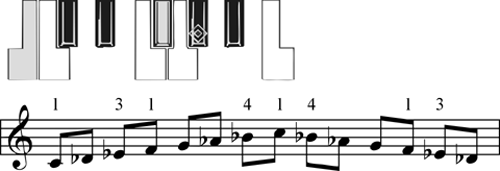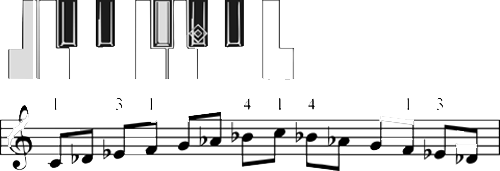Scale Fingering - Group 2
In the flat keys, the right hand remains over the C major position, uses the C major 1 2 3, 1 2 3 4 1 fingering, and simply substitutes black keys one at a time according to the key signature. White keys C and F are eventually flattened, becoming respectively white keys B and E. Eventually, the accumulated flats become (enharmonic) sharps. The G flat and C flat scales are shown here with their enharmonic equivalents F sharp and B major.
Don’t play the greyed out or missing notes in the keyboard diagrams. Always use the thumb for the top C (to rehearse playing these scales ‘for real’). Learn to play all nine keys right through to the end. The lozenge shape (◊) indicates the tonic (the home note and name note of the key). When you are familiar with the white-and-black-key combination of each key, break out of the C-to-C octave and play the scale from tonic to tonic using the manuscript examples given. You will then be able to see the logic behind the fingering for this group of scales (Group Two – Right hand flat keys).
This is a gif

This is a gif too:

This is a png

This is supposed to be transparent


Ex Photoshop, traced, PNG 8



Enjoy this page? Please pay it forward. Here's how...
Would you prefer to share this page with others by linking to it?
- Click on the HTML link code below.
- Copy and paste it, adding a note of your own, into your blog, a Web page, forums, a blog comment,
your Facebook account, or anywhere that someone would find this page valuable.
|